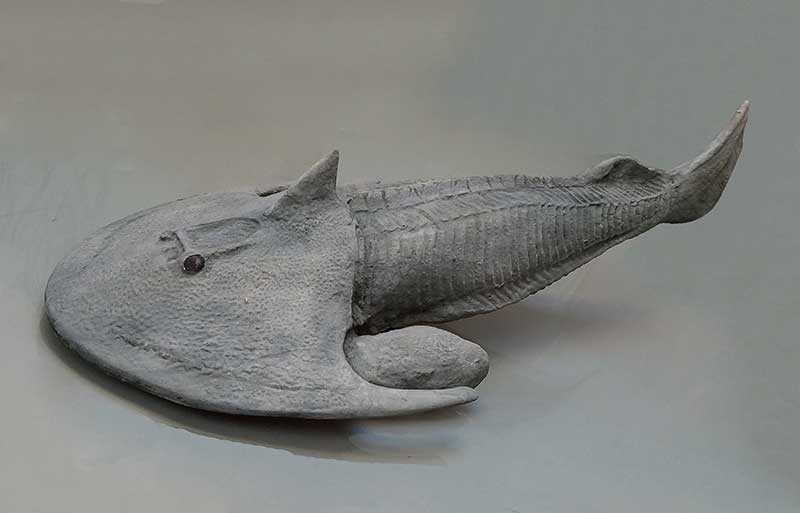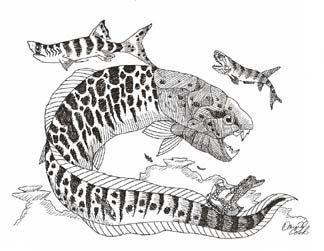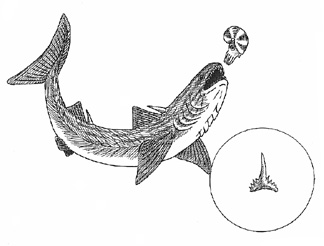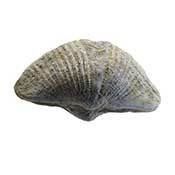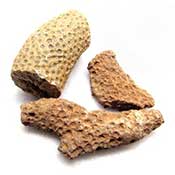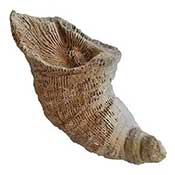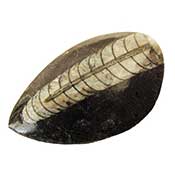Sign up for Lesson Plans, discounts & more!
The Devonian Period:
The Age of Fish (Old School)
What about Life Moving Onto Land?
The Devonian Period has been commonly referred to as the age of fish. Fish really do dominate the oceans during this time period but it is misleading. So much else happens: Plants and animals begin to colonize the land, reefs are being built, continents crash into each other, and mountains form to name a few. So let's take a look at the details. This fourth Period of the Paleozoic Era lasted from 417 million years ago to 354 million years ago. It is named for Devon, England where the old red sandstone of the Devonian was first studied.
The Continents During The Devonian
During the Devonian there were important changes in the land masses on the globe. North America and Europe had collided forming a large continent called Euramerica. This caused the formation of the Appalachian Mountain Range. The other large land mass was Gondwana. It was made up of South America, Africa, Antarctica, India and Australia. These two large land masses lay close to one another near the equator.
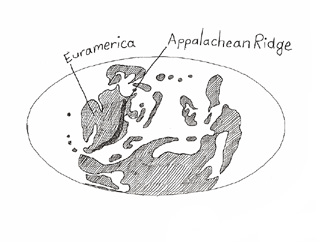
The two continents were moving toward each other throughout the Devonian Period. The waterway between the two continents covered a subduction zone. This is an area where one plate is moving underneath the other. Eventually this would mean that the two continents would collide to form the supercontinent Pangea in the Permian Period. That event is more than 64 million years later.
The Devonian Period- Life on The Land
Plants Cover The Land
Laying so close to the equator meant that the climate of the Devonian was warm. The warm temperatures made life on land particularly good for the plants. They developed vascular tissues to carry water and food through roots and leaves. The most important development was the seed. Now plants were not dependent on the presence of water for reproduction and they could move further inland. Ferns and the first trees began to cover the land.
Insects and Other Animals Find Homes On Land
The
plant-covered lands made a good home for the first wingless insects and
spiders. Even a primitive vertebrate, the tetrapod or four-footed
vertebrate, developed the ability to live outside the water and move on
land.
The Age of Fishes
The Devonian is known as the Age of Fishes. It is famous for the thousands of species of fish that developed in Devonian seas. We know this because of the fish fossils found in Devonian rocks. When fish first started to develop, they had no jaws and the support structure was made of cartilage. This material doesn’t fossilize well, so the earliest fossils were of fish whose outside skin was protected by scales and plates made of boney tissue. These fish were called Ostracoderms. Their name means “shell-skins.” These animals appear in rock from the late Silurian and early Devonian periods.
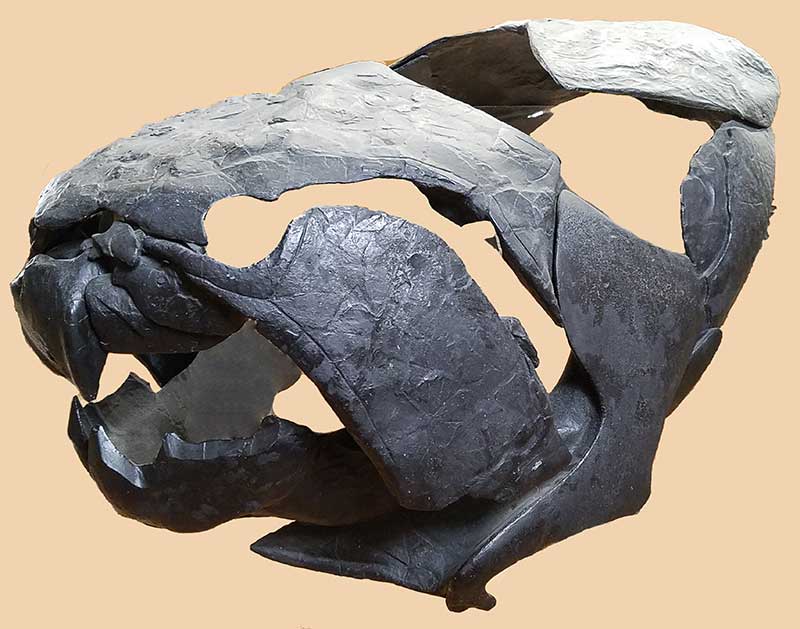
Fish with Jaws
The next development was the fish with jaws, gills and paired fins. The Placoderms
were the first fish to have all three of these characteristics. They
still had the “shell skin” of the Ostracoderms, but it mainly covered
the head and neck area. The largest of the Placoderms was the Dunkleosteus.
It was a huge predator in the Devonian seas. It could be as long as 10
meters. Instead of teeth, it had large boney plates that stuck down in
the front of its mouth opening. The powerful jaws were deadly to other
fish, sharks and even other Dunkleosteus.
Ancient Sharks
Sharks, or Chondricthyes,
developed during the Devonian also. Sharks are thought to be
descendents of the large Placoderms, but they lost the ability to form
the boney armor on the outside of the body and were unable to form bones
on the inside also. Their body is supported by cartilage. Because of
the skeletons of cartilage, very little fossil evidence is available.
They did leave behind their teeth. Much of the information we have about
ancient sharks comes from the many different types of fossil teeth that
have been found. Sharks first appear during the middle of this period.
The Bony Fish; Osteichthyes
The
bony fish appear during the middle Devonian Period. The first of these
are the lobe-fins. These fish have pairs of fins with fleshy lobes at
the base and more typical fin membranes at the ends. The lobes contain
jointed bones. These lobe-fins are thought to have evolved into “legs”
and eventually into amphibians that spend their lives both in and out of
the water.
The coelacanth is a lobe-fin fish that developed during the Devonian. For years it was thought to have gone extinct at the end of the Mesozoic Era along with the dinosaurs, but in 1938 a living coelacanth was caught. Since then coelacanths have been seen from time to time in the Indian Ocean.
The Lung Fish
The Dipterus
was a lungfish that developed at this time. In many ways
it looked like the lobe-fins with bony flesh at the base of its fins.
But the Dipterus had lung sacks branching off of its throat that got air
from the gills. During the Devonian Period, there were huge swings of
floods and drought. During drought times, when lakes turned into ponds,
the plants used all the oxygen in the little water that remained. A
Dipterus that was stranded in such a pool could stick its head out of
the water and get the air it needed to stay alive.
The Reef Builders
The
reef building work of the sponges and corals went on through the Paleozoic Era.
They built some of the largest reefs in the world. Invertebrates grew
well in Devonian seas too, so many new species developed. The ammonite is one of these.
Mass Extinction Ends The Devonian Period
Species
had begun to branch out and include both land and water habitats. The
Devonian Period ended with a mass extinction. The Devonian extinction
hurt the water habits much more than those on land. The sponges and
corals were the most affected. No major reef building happened again for
thousands of years.
Fossils from the Devonian Period for sale at our sister site Fossilicious.com
Check out some of the Educational Materials for sale on our sister site fossilicious.com.

interested in more? If so, you may want to check out our other sites:
fossilicious.com - Our online fossil and mineral rock shop.
rocksandminerals4u.com - An educational site about rocks, minerals, and geology.
Geologic Time Geologic Time Line
Cenozoic Era
Quaternary
Neogene
Paleogene
Mesozoic Era
Cretaceous
Jurassic
Triassic
Paleozoic Era
Permian
Carboniferous
Devonian
Silurian
Ordovician
Cambrian
Archean Time
Hadean Time
Teachers Resources
Activities for Education and Fun
Earth Science Lesson Plans
Activities For Kids
Fossil Lesson Plans
Fossil Activities
Education Articles
Coloring Pages
Dinosaur Coloring Pages
Montessori Materials
Geology Club
Fossil Hunting
 |
 |
 |
